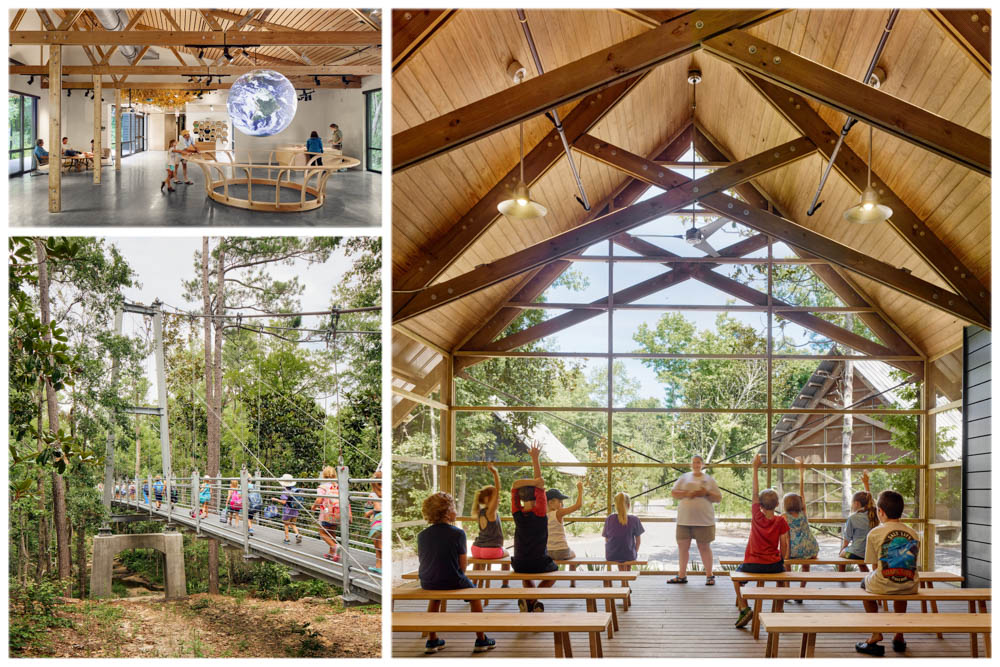USM’s Marine Education Center Named Best in Country for Architectural Design
Wed, 05/20/2020 - 04:08pm | By: Margaret Ann Macloud
 The American Institute of Architects (AIA) recognized the design team of USM’s Marine
Education Center (MEC), located in Ocean Springs, Mississippi, with one of its highly
sought-after Committee On The Environment (COTE) Top Ten Awards. The MEC is the only
building in Mississippi to ever receive this designation, which awards 10 outstanding
projects each year based on design excellence with environmental performance. This
award is designated as one of the industry’s best-known programs for recognition of
sustainable design excellence.
The American Institute of Architects (AIA) recognized the design team of USM’s Marine
Education Center (MEC), located in Ocean Springs, Mississippi, with one of its highly
sought-after Committee On The Environment (COTE) Top Ten Awards. The MEC is the only
building in Mississippi to ever receive this designation, which awards 10 outstanding
projects each year based on design excellence with environmental performance. This
award is designated as one of the industry’s best-known programs for recognition of
sustainable design excellence.
“Sustainability is the overarching theme of the award, but community engagement, wellness, connection to the site itself, economy and so many other factors are considered as well. Because only 10 projects are recognized annually, the Marine Education Center is now categorized alongside some of the most impressive architectural and sustainable buildings in the world,” said Matt Wallace, associate partner of Lake-Flato Architects, which designed the MEC with Associate Architect unabridged Architecture. “It’s the most rigorous project award submission we put together and the most rewarding for us, as it ties into our mission of creating environments that enrich communities and nurture life.”
After Hurricane Katrina, when the J. L. Scott Marine Education Center and Aquarium was destroyed, the MEC staff continued outreach programs despite the loss of the facility by moving to temporary metal buildings. Rather than teach in metal buildings, the team moved students outside, relying on the surrounding coastal environment to teach about the environment. This shift drove the design goals for the new MEC. The design of USM’s Marine Education Center reflects stewardship in the environmental sensitivity of the site, principals of coastal resilience, and supports and inspires teaching about ocean science, community resilience, and environmental stewardship.
“By moving programs outside of a physical structure, a shift in design goals began to occur from building a new building to go inside and teach about the environment to designing a facility that facilitated and supported teaching about the ocean by being outside in the coastal environments,” retired MEC director and building visionary Chris Snyder said.
The COTE Top Ten award establishes USM, specifically the School of Ocean Science and Engineering (SOSE) and the Marine Education Center, as a leader in innovative informal education. The recognition could potentially lead thousands to visit the site where they will learn about SOSE research.
"I see the Marine Education Center using this amazing new facility to dramatically expand their educational programs and outreach opportunities and enhance their ability to connect the public to the research that our scientists are doing,” said Dr. Joe Griffitt, Director of the School of Ocean Science and Engineering. “That they are doing this at the same time that the research activity of USM and the School of Ocean Science and Engineering is expanding so rapidly is tremendously exciting, and I am looking forward to seeing what new and innovative interactions they can build."
For the selection process, the AIA appoints a jury of distinguished industry professionals to select winning projects. The following was a statement from this year’s selection jury of the MEC facility design project:
“A very mature design effort, in every sense. Starting with extensive research of the site ecology and a clear desire to make an environmental education research center that embodies its purpose. The design team’s thoughtful care shows everywhere. The complex is ordered not by an imposition of a construct of some kind, but by finding sites that create minimal damage and that would be above the flood plain and remain inherently resilient. This is a Katrina replacement project. The design team lived through the hurricane; they understood what resilience meant more than most of us. The program of the center is seen from the start as buildings (interiors) and exterior spaces. It integrates the site and message of resiliency into the educational mission of the building, externalizing the program to make the outdoor classroom tangible. The architecture and construction is simple, economical, and renewable. An exemplary project for all of us to learn from.”
The project team includes:
Architect of Record/Design Architect: Lake| Flato Architects, Associate Architect: unabridged Architecture, Landscape Architect: Studio Outside, Engineer - MEP: TLC Engineering, Engineer - Structural: Datum Engineering, Lighting Designer: David Nelson & Associates, Engineer - Civil: Brown Mitchell Alexander, Environmental: BMI Environmental Services, Bridge Consultants: Seattle Bridge and HDR Engineering, Inc., Wayfinding Consultant: fd2s,Code Consultant: Garabedian Associates, General Contractor: Starks Contracting Co., Inc, Owner's Representative: M A Howard Consulting, LLC